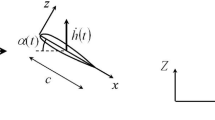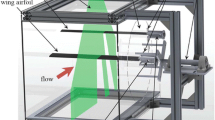Summary
Aerodynamic interactions of two airfoils in tandem configuration moving parallelly forward and down at large angle of attack after an initial acceleration from rest are studied, using the method of solving the Navier-Stokes equations in moving overset grids. In the early time of the motion, force coefficients on the fore- and hind-airfoils are almost the same and are both enhanced in comparison with that of the single airfoil. The mechanism for the enhancement is that each airfoil sees a faster incoming flow because of the ‘blockage’ effect caused by the presence of the other airfoil. After the early time, for the cases having only horizontal spacing,C L on the fore-airfoil keeps to be larger than that of the single airfoil, and the smaller the spacing is, the larger theC L is;C L on the hind-airfoil rapidly decreases to a lower level because of the interaction between the starting vortex of the fore-airfoil and the dynamic stall vortex of the hind-airfoil, and this detrimental effect becomes more severe as the spacing becomes smaller.C d behaves similarly. When the hind-airfoil is lower in vertical position than the fore-airfoil and their horizontal spacing is small (e.g. the vertical and horizontal spacings are 0.25c), large enhancement of the forces on the fore-airfoil (e.g.C L=3.0) and a noticeable enhancement on the hind-airfoil (e.g.C L≈2.2) can be obtained.
Similar content being viewed by others
References
Alexander, D. E.: Unusual phase relationships between the forewings and hindwings in flying dragon-flies. J. Exp. Biol.109, 379–383 (1984).
Norberg, R. A.: Hovering flight of the dragonfly Aeschna juncea L., kinematics and aerodynamics. In: Swimming and flying in nature (Wu, T.Y., Brokaw, C. J., Brennen, C., eds.) pp. 763–781. New York: Plenum Press 1975.
Wakeling, J. M., Ellington, C. P.: Dragonfly flight, II. Velocities, accelerations and kinematics of flapping flight. J. Exp. Biol.200, 557–582 (1997).
Weis-Fogh, T.: Quick estimates of flight fitness in hovering animals, including novel mechanisms for lift production. J. Exp. Biol.59, 169–230 (1973).
Somps, C., Luttges, M.: Dragonfly flight: novel uses of unsteady separation flows. Science28, 1326–1328 (1985).
Lan, S. L., Sun, M.: Aerodynamic properties of a wing performing unsteady rotational motions at small Reynolds number. Acta Mech. (forthcoming).
Rogers, S. E., Kwak, D., Kiris, C.: Numerical solution of the incompressible Navier-Strokes equations for steady-state and time-dependent problems. AIAA J.29, 603–610 (1991).
Meakin, R.: Moving body overset grid methods for complete aircraft tiltrotor simulations. AIAA Paper 93-3350 (1993).
Hilgenstock, A.: A fast method for the elliptic generation of three dimensional grids with full boundary control. In: Numerical grid generation in CFM '88, pp. 137–146 Pineridge Press 1988.
Author information
Authors and Affiliations
Rights and permissions
About this article
Cite this article
Lan, S.L., Sun, M. Aerodynamic interactions of two airfoils in unsteady motion. Acta Mechanica 150, 39–51 (2001). https://doi.org/10.1007/BF01178543
Received:
Issue Date:
DOI: https://doi.org/10.1007/BF01178543




